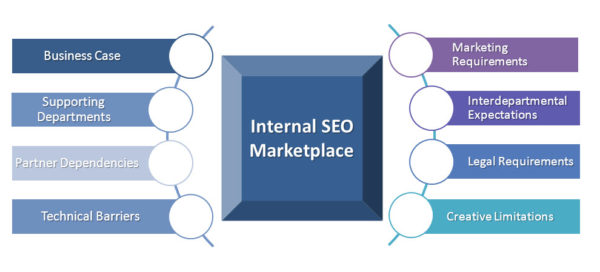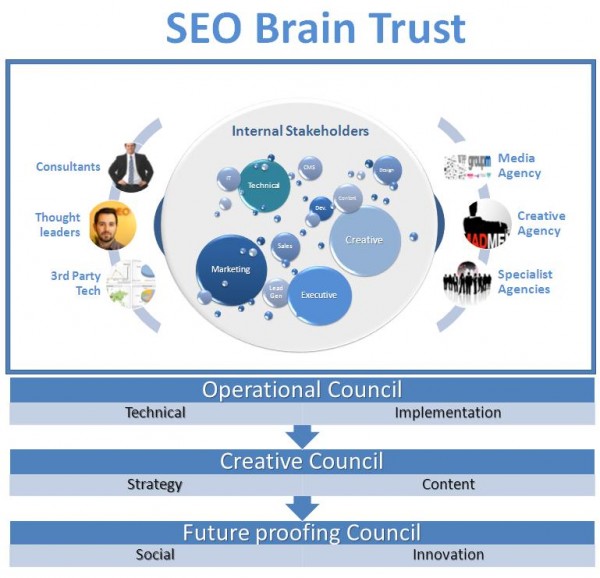Four Steps To Building A Powerful SEO Brain Trust
To the B2B marketer, few channels are as effective in driving results as a well-crafted SEO program. Whether the needs are lead generation, thought leadership, or competitive differentiation and brand engagement, organic results are the largest overall driver of traffic to websites according to market research powerhouse Forrester. However, when it comes to creating a […]
To the B2B marketer, few channels are as effective in driving results as a well-crafted SEO program. Whether the needs are lead generation, thought leadership, or competitive differentiation and brand engagement, organic results are the largest overall driver of traffic to websites according to market research powerhouse Forrester.
However, when it comes to creating a brilliant SEO campaign, things are not as easy as simply building a website and hoping the Search Engines smile favorably on your effort. This is due not only to the unique virtues of the almighty algorithm, sacred as it is, but also the complexity in rallying the resources needed to effectively engage the organic ecosystem.
To be successful, you must be brilliant at navigating both the internal marketplace as well as the external marketplace.
Are You Operationally Ready For Successful SEO?
When it comes to SEO, so many of us focus on the tactics and the strategies to move the dial in the engines, but rarely do we discuss what it takes to fuel those efforts. Creating a scalable and effective SEO marketing infrastructure can be challenging for even the most tenured marketer.
It’s rather easy to underestimate the amount of resources that are required to effectively move the needle in the short and long-term. This is due in large part to the number of stakeholders internal and external who are required to play a part in the SEO process.
As you no doubt know, being found in the Search Engines can be a daunting challenge. However, the effort required to be found in the SERPS often pales in comparison with the internal marketplace challenges we face.
Due to our dynamic business environments and organizational complexities, it can be a struggle to formulate an effective SEO approach when the supporting infrastructure is not aligned to serve the interests of the campaign.
Since SEO is such a complex channel and is dependent on so many internal resources, the question becomes: how do you corral the goodwill of your teams and produce not only an SEO program that will generate the results you need, but scale for long term growth?
The good news is that the answer to the challenge is within your control. To maximize your efforts, you will need to create your very own SEO brain trust that is within your sphere of influence.
Below you will find 4 steps to help you create an internal brain trust to ensure that your SEO efforts are being optimized internally so that when you start talking about things like rel=”canonical”, everyone is aware and ready to do their part.
Step 1: Identify SEO Interests
To do this, examine the various departments within your organization who will have a direct benefit from the SEO campaign. One thing to keep in mind is that there will scarcely be a department who is not benefiting in some way with improved site performance, if for no other reason that it will translate into more business overall.
More traffic means more likelihood of business transactions and higher revenue to the bottom line. Beyond this, drill down and think about the interest of each group and how being found in search translates into success for them.
As an illustration, perhaps your website has a section dedicated to careers. While the HR group knows that the website is important, have they been involved? If not, understand their needs and map their interest to your efforts in SEO. If candidates receive an email for a great role, but when they search for the company find nothing, will this help or hurt the recruitment effort?
Through reasoning out interests, you can begin to lay out the benefits for each group and be prepared to include them in your SEO effort when the time is right.
Step 2: Assemble Your Tribe
Once you have the interests identified, the next phase is to spotlight the stakeholders who are directly tied to the execution. Most directly, this will be the individuals who produce content and are responsible for implementation at the organization.
Oftentimes, if you are in a medium to large sized business, these functions can be spread out through a few departments that represent a loose confederation of individuals who are not wholly vested in one practice area.
Once you know who the teams are that have influence on the implementation of your SEO strategy, you must incorporate them into the SEO program.
For example, the creative team might be tasked with generating amazing content on business topics, but are they aware of the reality that even if their work is stellar, it will mean nothing if it’s not findable in search when prospects and clients might be looking?
Alternatively, to a technical resource, the idea of implementing your SEO changes is just another ‘project in the queue’.
Are they aware of the overall site performance improvements that will be made if they accelerate the implementations?
In the end, there will be a host of individuals who contribute to the content and operation of your website portfolio, and bringing these folks to your cause is a key step in building your brain trust.
Step 3: Assess Your Organizational SEO Awareness
Once you have identified the parties who have a vested interest, it’s important to have an honest assessment of where in the operational threshold the stakeholder groups are in terms of their SEO appreciation. It does little good to have a group of interested parties who are all unaware of the subject matter and what it means to their day to day.
If you are in an organization where the overall SEO sophistication is low, you will need to invest time and energy into bringing everyone up to speed on what they will need to know.
At a basic level, most people will understand that being in position 1 on a SERP is better than position 25. What they might not know is what they can do to help out to improve rankings.
Creating a series of educational modules or sessions is a great way to lay the groundwork and bring everyone up to speed. If you are in a complex business environment, it might make sense to host a series of Web conferences, or optimally, an annual summit where every vested stakeholder gets to meet the other groups and network.
As your teams get up to speed, the overall speed to market in your SEO programs improve, and you can focus on the core strategies and tactics.
Step 4: Create SEO Core Practice Councils
Finally, now that you have identified the interests, aggregated the stakeholders, and assessed their subject awareness of SEO, the final step is to create a framework to maximize their insights in meaningful way to your SEO effort.
Instead of having to project manage this process independently, one idea is to create different councils or think tanks to reduce overall workload and engineer ground level production. This is also great for team building and further SEO evangelization as the year unfolds and dimensions are added to the SEO ecosystem.
After all, the search engines are always evolving, and 2012 is already witnessing major updates from the search engines. Being able to adapt to these changes with the vested stakeholders in step will be a major efficiency gain.
When you think about how to maximize your efforts, think about the human capital within your organization to achieve SEO results in your program.
While we know that the B2B realm is quite challenging, it’s by leveraging the power of many within your own networks that you can put scale to your effort, and ensure that SEO is operating optimally across that entire business. The life of a B2B marketer is one of perpetual ingenuity where keeping an eye on budgets that are razor thin is an imperative.
In the case of SEO where the there are many stakeholder teams and resource areas that are required to produce results, success belongs to those who can fully leverage their available teams, and harness the power of their own vested brain trust.
Opinions expressed in this article are those of the guest author and not necessarily Search Engine Land. Staff authors are listed here.
Related stories



